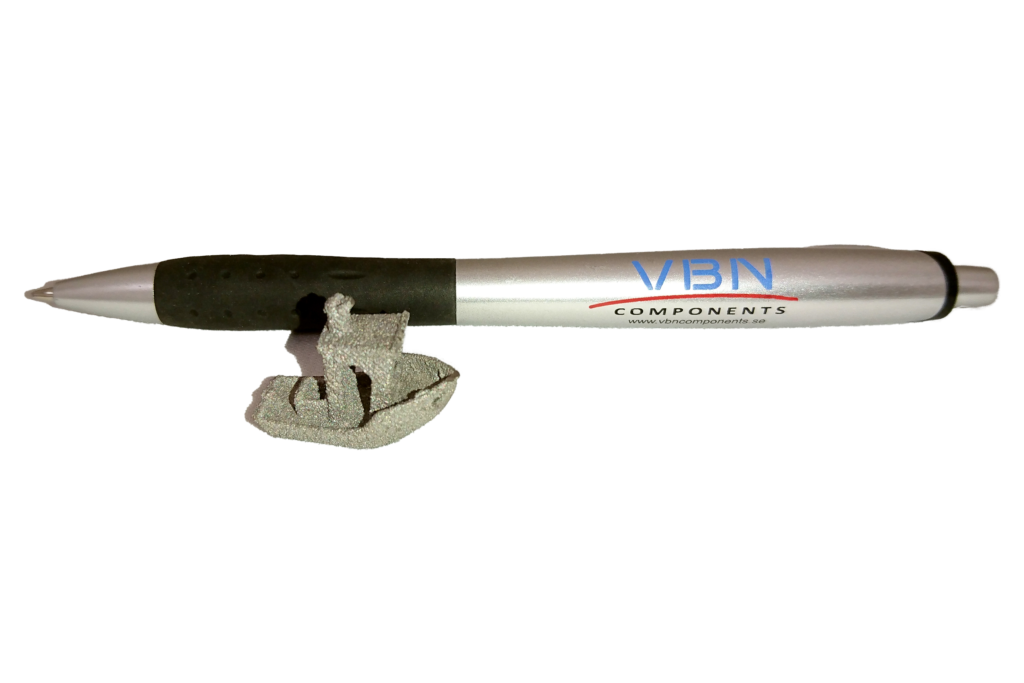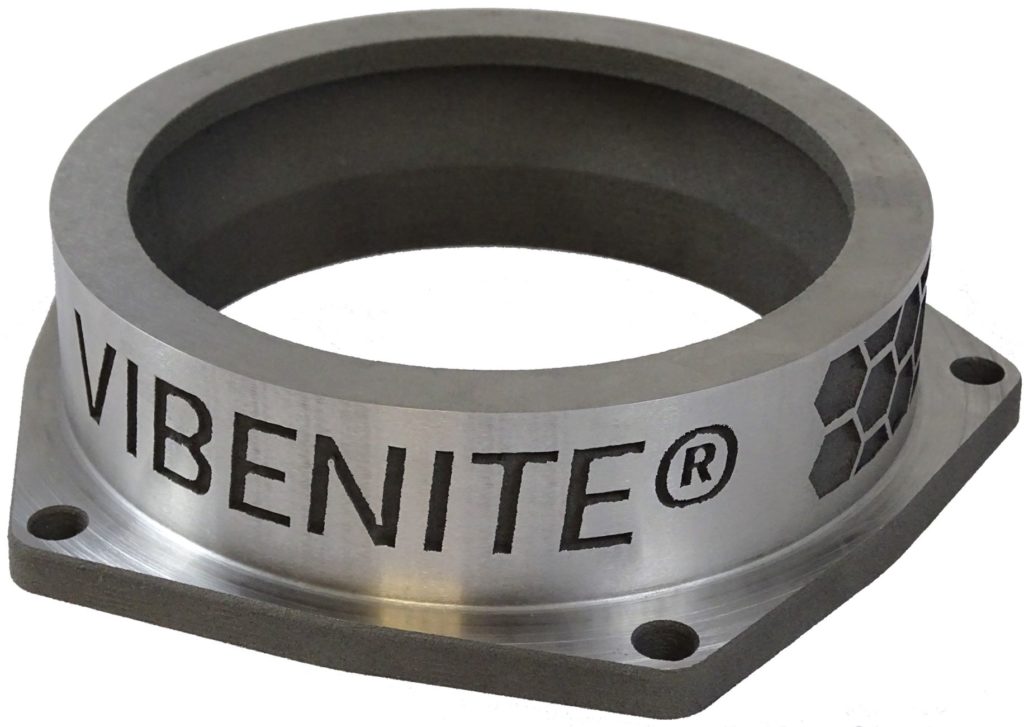
VBN Components is a Swedish materials development company, established in 2008. It is niched towards extremely wear and heat resistant additively manufactured (AM) alloys, which was quite bold back in the days when it was considered “impossible” to produce AM materials with high carbide content. Since then, VBN Components has launched ground-breaking products within its range of Vibenite® materials, such as “The world’s hardest steel”, Vibenite® 290, in 2017 (hardness ~72 HRC), and the hybrid carbide Vibenite® 480 in 2018 (hardness ~70 HRC).
Customers can order components from VBN, but also get a license to produce Vibenite® components in-house. Vibenite® materials have a strong competitive edge. Components in need of wear resistance have proved to last ten times longer than corresponding ones made with traditional steel, after replacing the old material with Vibenite®. Shortened lead times for product development and alterations thanks to additive manufacturing are other important factors. Testing new designs or adapting parts to specific needs such as cooling channels or reduced weight becomes very accessible. The paradigm shift lies in the possibility for customers to use a much better material in the final application, since so many limitations from traditional production are removed.
SKF and VBN in Additive Manufacturing Cooperation
Earlier this year it was revealed that VBN collaborates with SKF, a world leader in bearings. SKF and VBN Components have been working together for several years within additive manufacturing of hard and highly wear resistant steels with significantly enhanced fatigue properties. The latest joint project is within large size bearings, where lighter weight components have the potential to improve performance under demanding conditions and will enable further weight optimization of machinery. Previous collaborations with SKF have shown that Vibenite® materials provide very good rolling fatigue resistance due to their purity, hardness, and fine microstructure.
Exceptional Wear Resistance for Vibenite® 350
A Vibenite® material that is usually not highlighted in the media is corrosion resistant Vibenite® 350. However, its wear rate has now been measured to be only 1/6 to 1/7 of the wear rate of conventionally processed austenitic stainless steel grades! This indicates an exceptional wear resistance, primarily attributed to microstructural features such as high carbon content, as well as size, shape and distribution of the carbides.
Researchers from The University of Manchester have published the results in the open access article “Wear resistance of an additively manufactured high-carbon martensitic stainless steel” in Nature Scientific Reports. The article quotes: “The wear rate was superior to L-PBF-processed and conventional-processed austenitic SS; it was even similar to the EBM-processed tool steels at low applied load.” So, if you are in need of a truly sustainable corrosion resistant steel, Vibenite® 350 might be what you are looking for!
Vibenite® 480 Printable with Laser Powder Bed Fusion
As a standard, Vibenite® materials are produced with EBM. However, trials with different production methods have been tested, and hybrid carbide Vibenite® 480 has now shown suitable for L-PBF. The Institute for Tooling and Manufacturing Technology of the University of Applied Sciences, Cologne, Germany has successfully printed VBN’s hybrid carbide Vibenite® 480 with L-PBF. Vibenite® 480 is an alloy with high hardness and extremely high carbide content. The metallurgical stability of the material makes it easy to melt with L-PBF. The results were presented on May 12th at the conference “Fachtagung Werkstoffe und Additive Fertigung” in Dresden, Germany, entitled “Qualification of the Hybrid Carbide WC-Cr3C2-CoCr for Laser Based-Powder Bed Fusion”.
Increasing Interest from North American Organizations
In the past couple of years VBN Components has increased sales in North America. To name an example, in 2021 VBN delivered an important number of samples to the US Armed Forces of three Vibenite® alloys for testing of the materials’ performance in several applications and setups. The main goal for the customer is to increase the lifetime of components and the uptime of their systems. Tests are still ongoing.
In May 2021 it was made official that the Vibenite® series of materials are being used by Canadian engineering company Exergy Solutions, and that they will be printed with Calibur3 machines from UK based Wayland Additive. Billy Rideout, CEO, at Exergy concluded: “The alliance between Exergy, Wayland, and VBN means that we are able to offer significant customer benefits. With support from VBN, Exergy can now supply full-service design, manufacturing, and qualification support for large parts with complex geometries made from materials that are difficult or impossible to machine. This in turn means longer component lifetimes, with the entire part (not just specific areas of the part) made from highly wear resistant materials.”
To expand North American relations, VBN will make its first appearance at the IMTS show in Chicago 12-17 September. If you are planning to visit the show, you will find them in the AM Pavilion, West Building, Level 3. Take the chance to explore how you could improve component lifetime, try out new designs, shorten lead times and reduce your environmental impact!

VBN Components is constantly refining the process parameter settings, here proven by a tiny “3d benchy”.
Subscribe to Our Email Newsletter
Stay up-to-date on all the latest news from the 3D printing industry and receive information and offers from third party vendors.
You May Also Like
NSF Awards Kentucky $1M for Advanced Manufacturing
The National Science Foundation has awarded a $1 million grant to the University of Louisville for the Advancing Manufacturing and Building Construction Technologies (NSF AMT) project. This initiative is part...
3D Printing News Briefs, May 11, 2024: 3D Printed Stent, Tower, Sculptures, & More
We’re starting off with medical research in today’s 3D Printing News Briefs, as researchers in Korea used CT images and 3D printing to fabricate an educational simulator for a mastoidectomy....
3D Printing Unpeeled: Wind Turbines, Probiotics and Lenses
TPI Composites, ORNL and Ingersoll Rand are working to make wind turbine tooling segments that can be 18.3 meters long. These elements also include resistive wires that help keep the...
Tethon 3D Releases Cost-effective Bioprinter
Tethon 3D, known for its ceramic-loaded DLP materials, custom resins, and DLP 3D printers, has recently released a bioprinter. Vat polymerization printers like DLP systems have been widely used by...




































